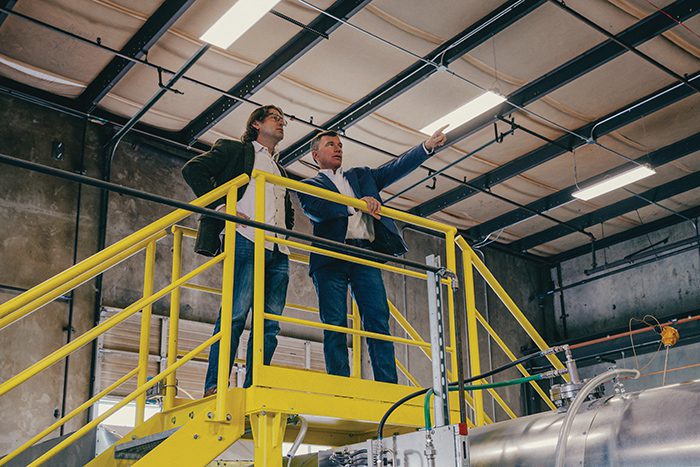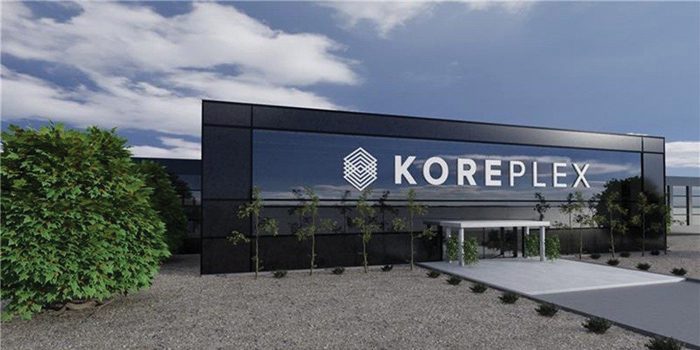Global Market Expanding for Battery Makers
The global market for batteries continues to grow, as demand for battery power accelerates across several industries, from electric vehicles (EVs) to electronic devices, and for energy storage in the power generation sector. New battery materials are being developed as manufacturers look for ways to increase energy density and provide longer-lasting modes of power.
SK materials, part of the South Korea-based global SK Group, recently announced a joint venture with U.S.-based battery materials company Group14 Technologies, in which the companies will build a major factory for lithium-silicon battery technology in South Korea. SK materials led a $17-million Series B funding round for Group14 in December of last year, and the company is investing $52 million in the battery manufacturing hub.
 |
|
1. Group14 Technologies CTO Rick Costantino (left) and CEO Rick Luebbe look over the manufacturing floor of the company’s commercial-scale Battery Active Materials, or BAM, factory in Woodinville, Washington. Courtesy: Talia Green / Group14 Technologies |
It’s one of many battery manufacturing ventures unveiled in recent weeks; Group14 earlier this year announced the launch of a commercial-scale 27,000-square-foot U.S. manufacturing factory, located at its headquarters complex in Woodinville, Washington, to meet demand for higher-performing lithium-silicon anode materials. The facility is the first of several Group14-planned commercial manufacturing sites to advance energy storage technologies. Group14 in announcing the Washington facility (Figure 1) said its commercial manufacturing factory “is capable of producing 120 tons per year of Group14’s breakthrough lithium-silicon technology, SCC55 (Figure 2), which can deliver up to 50% more energy density per volume than lithium-ion batteries available on the market for automotive and consumer electronics applications.”
|
2. Group14’s flagship silicon-carbon anode material, SCC55, can unlock 50% more energy density compared to conventional lithium-ion, according to the company. Courtesy: Talia Green / Group14 Technologies |
Group14’s lithium-silicon technology is the type of technical advancement that has caught the eye of government officials. A bipartisan group of representatives in the U.S. House in late July introduced the “Battery Material Processing and Component Manufacturing Act,” a measure designed to strengthen the U.S. battery manufacturing industry. The measure would provide financial grants for the construction or retooling of facilities for processing battery materials, or manufacturing of battery components. The U.S. Dept. of Energy already has announced a $42.3 million funding opportunity to support manufacturing of technologies, including batteries, “to drive economy-wide reductions in carbon emissions.”
 |
|
3. The KOREPlex, a 1-million-square-foot battery manufacturing facility in Arizona, is being developed by KORE Power. Groundbreaking is scheduled by the end of this year. Courtesy: KORE Power |
Idaho-based battery cell technology developer KORE Power in late July announced it will build a manufacturing facility in Maricopa County, Arizona, what it calls the first lithium-ion battery factory wholly owned by a U.S. company. The 1-million-square-foot factory, known as the KOREPlex (Figure 3), will support up to 12 GWh of battery cell production. Groundbreaking is planned before the end of this year, with commercial production starting in mid-2023.
Initiatives to promote investment in battery technologies are occurring worldwide. LG Energy Solution and vehicle-maker Hyundai recently said they would jointly invest about $1.1 billion to build an EV battery cell manufacturing center in Indonesia. “With this battery cell manufacturing venture, the group and LG Energy Solution are further strengthening a strategic partnership that started more than a decade ago,” Hyundai said in a statement. “The new factory will help Hyundai and Kia produce vehicles with high efficiency, performance, and safety by supplying battery cells optimized for the two automaker’s battery EV models.”
Bakar Sadik Agwan, a senior automotive consulting analyst at GlobalData, a data and analytics company, in an email to POWER wrote, “Indonesia, which has reserves of nickel and cobalt used in Li-ion cell batteries, is well positioned to meet that demand amid advancements in EV technology. As a result, the 50:50 JV [joint venture] will be of high strategic importance to Indonesia from an EV perspective and surely a win-win for both LG and Hyundai. Hyundai, which aims to expand the portfolio of EVs to 44 models by 2025, will secure adequate supply for its future EVs and LG will strengthen its global presence in the EV market.”
The Hyundai-LG announcement comes as global automakers maneuver to secure their own battery supply chains to cope with growing demand for EVs. Ultium Cells, an Ohio-based battery manufacturer and a joint venture of LG Energy Solution and General Motors, in April announced a more than $2.3 billion investment to build a battery cell manufacturing plant in Tennessee.
A recent report from Praxis Global Alliance, a consultancy based in India, said the stationary storage market within battery energy storage systems (BESS) will experience major growth over the next decade. The group said BESS installations will continue to utilize lithium-ion technology, and said it expects battery prices will fall an average of about 6% each year until at least 2030. The report cited information from the International Energy Agency that said India would lead the battery storage market, deploying more than one-third of all global storage systems over the next 20 years, mostly because the country is ramping up its use of renewable energy, particularly solar—with the expectation solar farms will be paired with energy storage.
Investors have been pouring money into the lithium mining and battery production sectors, in part due to the growth in BESS installations but also due to projections that EVs are on a rapid growth trajectory. The Solactive Global Lithium index, which tracks the performance of the largest and most-liquid listed companies active in exploration and/or mining of lithium, or production of lithium-based batteries, jumped more than 34% from year-end 2020 through the end of July 2021. EV sales in China and Europe have surged this year; almost one of every five new passenger vehicles sold in Europe in June was a plug-in EV.
Expect that growth to continue, as the European Union in July said it may ban cars powered by diesel or gasoline by 2035. Volkswagen, the largest global carmaker, recently said its EV sales jumped 165% in the first six months of 2021. BYD Auto, the automotive subsidiary of China’s BYD Co., said its sales rose 154%. In the U.S., the Biden administration recently announced a goal of having EVs account for at least half of all vehicles sold by 2030.
Battery manufacturers are spurring rapid technology advancements, looking at new materials in an effort to improve energy density and efficiency, as well as safety. Rick Luebbe, CEO and co-founder of Group14 Technologies, told POWER that his company specifically is about “commercializing a silicon-carbon composite, a lithium-silicon composite with higher energy density, so that we can improve the dollars per kilowatt hour, driving [battery technology] toward cost parity with internal combustion engines. A traditional lithium-ion battery has used a graphite anode, but the anode takes up roughly 60% of the energy volume. Our play is to replace that old-style electrode with a silicon-carbon composite with a much higher capacity… [to] shrink the size of the anode, and put in a lot more cathode, and increase the energy density.”
“We’re focused on the electrification of everything,” said Luebbe. “What we bring to battery technology is much better energy density. In virtually every application, we can extend the runtime of that application.”
Luebbe said Group14’s construction of a major U.S. manufacturing facility, and its partnership with SK on a South Korean factory, is about overcoming potential supply chain disruptions—something many industries have battled during the global COVID-19 pandemic. “SK group is one of the largest conglomerates in Korea,” Luebbe said. “In the battery materials space, they recognize that our technology is important, based on performance and the ability to scale quickly. And it’s about cooperation along the supply chain. We and SK saw the need to put a plant outside the U.S. Because one of the target markets for us is EVs, and because they [SK] demand dual-sourcing, they have to have secure supply chains.”
“As one of the world’s largest global manufacturers, we recognize that we must pre-emptively address potential supply chain challenges to stay ahead of the demand,” said Kiseon Park, vice president of SK materials. “We are excited to enter into a joint venture with the Group14 team to bring a high-performing battery material solution to market for a wide range of applications within our product portfolio and beyond.”
“We wanted to provide that second, completely independent manufacturing structure,” said Luebbe. “In this case, by forming the joint venture, we established that second-source capability. It enhances our ability to get adopted for automotive applications.” Luebbe said advancements in battery technology for utility-scale energy storage deployments depend on factors not present in EV markets, which could slow the pace of new technologies. “I think [grid-scale] is going to be a little bit behind EVs in terms of adoption” of new technologies, he said. “It’s hard to estimate in the grid space… you’re really dependent on the utilities for adoption. We think the absolute key metric [for use] is dollars per kilowatt hours, per cycle. Otherwise, it’s cheaper to re-generate power later rather than save it.”
Luebbe said with growth in EVs expected to be “pretty consistent between the European market, the U.S., and Asia … the immediate exciting focus is EVs. What’s exciting from my perspective, the whole lithium-ion market today is about a $45 billion industry. But if every car made last year was an EV, it’s $1 trillion. And I don’t think it’s a question of whether all vehicles will be electric, it’s a matter of when.”
Luebbe said a “key imperative” for manufacturers is “creating value in the space, getting to cost parity,” and also that “these new technologies need to drop in to existing battery infrastructure. There’s really not enough time to go back and retrofit.” He also said any battery technology “has to be commercially scalable,” and government support helps the cause. “It’s important for markets to have their own domestic supply chains,” he said, noting the disruptions caused by the pandemic. “The best way to do that is for the government to establish incentives for battery supply chain initiatives.”
—Darrell Proctor is a senior associate editor for POWER (@POWERmagazine).